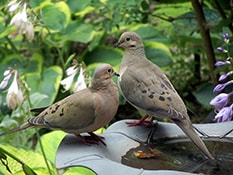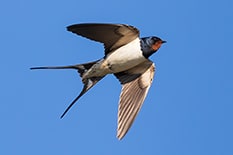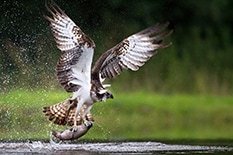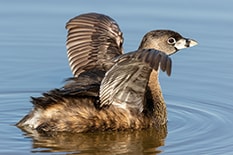
by NIAS | Aug 1, 2023 | Beginning Birder
Mourning Dove (Zenaida macroura)
Mourning Doves are a common bird in North America, related to Rock Pigeons. They can be found in a wide variety of habitats, including backyards. They are primarily seed eaters and will feed on the ground. They may visit bird feeders for any fallen seed, especially millet. They are often seen perching on telephone wires in pairs, easily recognized by their silhouette.
Mourning Doves have a small head with thin, black bills and a plump body. They have pale peach-colored feathers, with gray on top. There are scattered black spots on the wings with pink iridescence and sometimes a small black mark on the neck can be seen.
They are recognizable for their sad, mournful “coo coo” song that gives them their name. When in flight, they make loud whistling sounds and may clap their wings, which could help to scare a predator or give warnings to other birds.
After a Mourning Dove forms a pair bond for the breeding season, they will build a flimsy nest. Nests can be found typically in trees and grounds, but can also be formed in gutters and eaves of houses. They will lay two eggs, but multiple times during a breeding season.
To help protect Mourning Doves and any other bird, please leave your cats indoors. Ground-dwelling birds are easily caught and killed by cats. We can help birds by keeping our cats inside.
* Thanks to allaboutbirds.org.

by NIAS | Jun 1, 2023 | Beginning Birder
Barn Swallow (Hirundo rustica)
Swallows are a group of birds known for their small beaks that are suitable for catching insects in flight. Swallows are fun to watch as they glide quickly through the air, gobbling up many insects. The Barn Swallow is the most abundant and widely distributed swallow species throughout the world. Because they are insect eaters, they must migrate to warmer areas when winter approaches, such as South and Central America to maintain their food supply. They will return north to breed.
They are iridescent blue on the upper side of the body and orange-brown on the underside of the body. They are unique from the other swallow species with their deeply forked tail. They also fly lower than other swallows when foraging for prey. They can fly so low to the water that they can contact the water and even take a drink.
As the name suggests, they are often found in barn areas, but also found in many other habitats like open fields, wetlands, and other aquatic habitats. For breeding, they require open areas and human-made structures, such as eaves, rafters, barn supports, and bridges for building their nests. Both males and females collect mud, mix it with grass, and build a cup nest together that is about 3 inches across and 2 inches deep. They may often reuse the nests after cleaning out old feathers and adding new mud.
While Barn Swallows are not likely to visit your bird feeder, you can go visit them in their common habitats. Enjoy their fast and aerodynamic flights and try to identify them if you can! To help swallow populations, learn about the effect of pesticides on the food web. They require insects for their diets, so killing insects will harm insectivores. Additionally, if you fish, discard of fishing line properly so birds do not get tangled in the lines.
* Thanks to allaboutbirds.org.

by NIAS | Apr 27, 2023 | Beginning Birder
Osprey (Pandion haliaetus)
This year’s theme for World Migratory Bird Day is water and the Osprey is one of the ten featured ambassador birds to help educate the importance of water to birds. Osprey are typically found near any body of water, from freshwater to marine. They are a unique in that they are the only hawk that feeds primarily on fish.
Ospreys are mostly brown on the upperparts and white on the underside. The adults have a brown eyeline stripe, yellow eyes, and a sharply hooked bill. They have slender bodies with narrow wings and long legs. They are easily identified in flight with their brown wrists and a kink in their wings, creating an M shape in flight. To catch their prey, they dive feet first into the water and often fully submerge (no more than three feet below surface) to grasp their prey. They have unique feet with a reversible outer toe, which allows them to hold on to their slippery prey with two toes in front and two in back.
Ospreys usually mate for life. Together they build very large nests and require a platform-like surface or similar placement. Humans can assist by providing nesting platforms in areas where Osprey breed. Ospreys are endangered or threatened depending on the state due to the use of DDT pesticides from the 1950s to 1970s. The pesticides poisoned the birds (as well as other species) and caused their eggshells to thin, leading to severe decline in populations. Today, their populations are improving but they are still at risk of entanglement and death due to plastic pollution that can be tangled in their nests.
* Thanks to allaboutbirds.org.

by NIAS | Feb 1, 2023 | Beginning Birder
Pied-billed Grebes (Podilymbus podiceps)
Pied-billed Grebes are a type of aquatic diving bird. Although they look like ducks, coots, or loons, they are most closely related to flamingos. Often described as “part bird, part submarine,” they are known for their amazing diving skills. The genus in their scientific name, Podilymbus, means “feet at the buttocks” because their feet are close to their backside to help them propel through the water. They have lobed feet instead of webbed feet like ducks. They sure do move fast! Grebes have dense and waterproof feathers that they can adjust to change their buoyancy in the water. This allows them submerge most of their body underwater.
Pied-billed Grebes are small and chunky with a compact body and blocky head. They have a short, thick yellow-brown bill during nonbreeding season, but during the breeding season, the bill is white with a vertical black band, giving the descriptor “pied” to their name.
Pied-billed Grebes eat mostly crustaceans and small fish, but will also eat crabs, shrimps, snails, mussels, and aquatic insects and/or their larvae. A unique behavior with grebes is that they eat their own feathers and feed them to their young; the feathers act as sieves the prevent parts of their prey from passing too far into their digestive tract. Like birds of prey, they will regurgitate a pellet.
Look for these birds in freshwater areas but look fast – they dive down and swim away quickly!
* Thanks to allaboutbirds.org.




